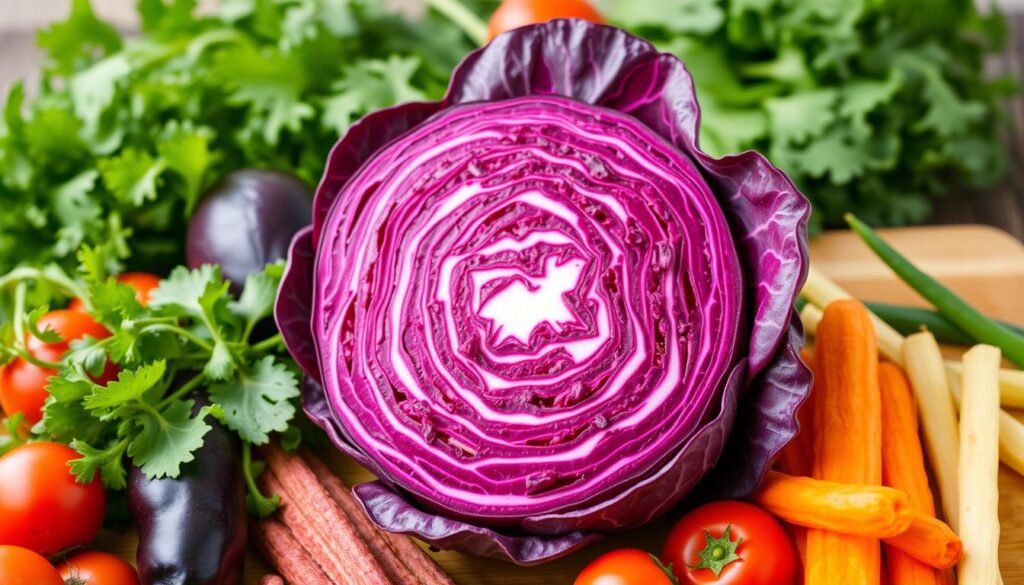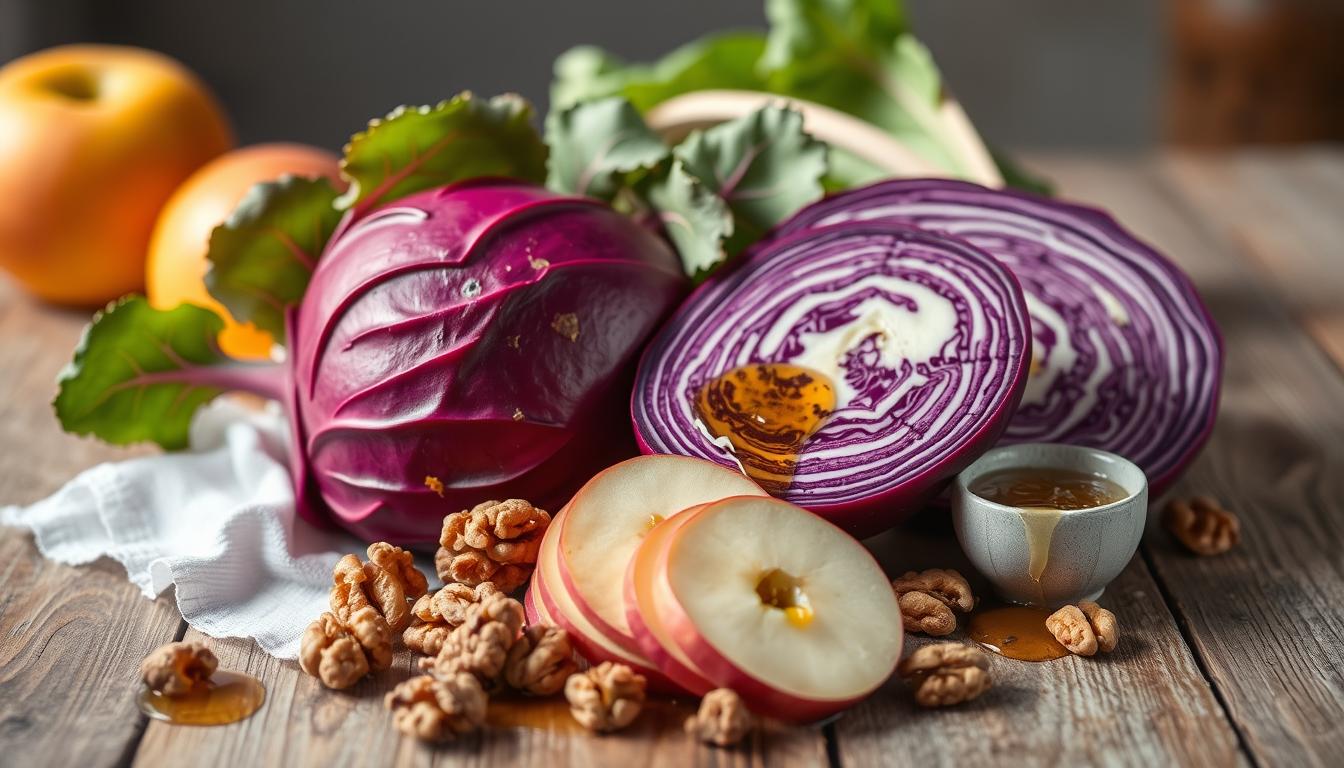Red cabbage is a versatile and flavorful vegetable. It can be paired with many ingredients to make tasty and healthy dishes. From savory meats to tangy fruits, it adds a unique flavor that goes well with different foods. In this guide, we’ll show you the best ways to use this vegetable in your meals. This will help you enjoy its rich taste and health benefits.
Key Takeaways
- Red cabbage is a versatile vegetable that can be used in a variety of dishes.
- It pairs well with a range of flavors, including savory meats, tangy fruits, and aromatic spices.
- Incorporating it into your meals can add a unique depth of flavor and a nutritional boost.
- Explore classic pairings, as well as international cuisine inspirations, to discover new ways to enjoy this veggie.
- Cooking tips and recipe ideas will help you make the most of this nutrient-rich vegetable.
Introduction to This Colorful Vegetable
Red cabbage, also known as purple cabbage, is a versatile and nutritious member of the Brassica family. It’s prized for its deep, rich color and its slightly sweet, peppery flavor. Whether you’re a seasoned chef or a home cook, understanding this ingredient can open up a world of delicious possibilities.
What Is It?
This vibrant vegetable is a variety of cabbage known for its striking purple-red hue. Unlike the green variety, it has a more robust flavor, with a subtle crunch and a slightly tangy undertone. This makes it a popular choice for many dishes, from vibrant salads to hearty stews.
Nutritional Benefits
This colorful red cabbage is not just appealing to look at and taste. It’s also a nutritional powerhouse. It’s packed with essential vitamins, minerals, and antioxidants that offer numerous health benefits. A single cup of raw cabbage contains:
- Vitamin C: Nearly 85% of the recommended daily intake
- Vitamin K: Over 60% of the recommended daily intake
- Vitamin B6: Approximately 10% of the recommended daily intake
- Fiber: About 3 grams, which is 12% of the recommended daily intake
- Potassium: Roughly 4% of the recommended daily intake
The vibrant pigments in this vegetable are also a rich source of antioxidants. These can help protect the body against oxidative stress and various health conditions. 
“This colorful cabbage is a nutritional powerhouse, packed with essential vitamins, minerals, and antioxidants that can provide numerous health benefits.”
Classic Pairings
This vegetable is a staple in many cuisines, known for its versatility. It pairs well with both savory meats and sweet, tangy ingredients. This makes it a key ingredient in dishes loved for generations.
It’s often paired with meats like braised beef or pork. The sweetness of the vegetable balances the meat’s richness. It also contrasts nicely with sausages, adding a crisp, tangy touch.
| Traditional Dishes | Common Combinations | Classic Recipes |
|---|---|---|
| Braised Cabbage with Apples | Cabbage and Pork | German-Style Rotkohl (Braised Cabbage) |
| Slaw | Cabbage and Sausage | Pickled Cabbage |
| Unstuffed Cabbage Rolls | Cabbage and Beef | Apple Salad with Cabbage |
In both savory and sweet dishes, this vegetable is a favorite. Its ability to enhance many flavors has made it a staple in classic recipes loved for ages.
Flavor Combinations
This versatile ingredient goes well with many foods. Its earthy taste and bright color add depth and beauty to dishes. It’s great with both savory meats and sweet fruits, thanks to its complex flavor profiles.
The vegetable is perfect for complementing rich, hearty foods. It pairs well with braised meats like goulash, roasted pork, or beef stew. Its sweetness balances the bold flavors, making meals satisfying.
It also pairs well with sweet and tangy ingredients. Its bright color and crisp texture are great with fruits like apples, pears, and citrus. These combinations are perfect for salads, slaws, and side dishes.
| Flavor Profiles That Pair Well | Savory Pairings | Sweet and Tangy Pairings |
|---|---|---|
| Rich, hearty flavors | Braised meats, goulash, roasted pork, beef stew | Apples, pears, citrus fruits |
| Sweet and tangy | – | Salads, slaws, side dishes |
This vegetable is great for adding color and crunch to your meals. It’s also perfect for balancing bold flavors. Try it in your cooking to make your dishes stand out.
“This vegetable is a culinary chameleon, adapting to both savory and sweet flavors with ease.”
Savory Dishes
This ingredient pairs well with many savory meats. It creates delicious and hearty dishes. From classic to creative, the options for recipes are endless.
Meat Combos
Cabbage and pork is a popular pairing. The sweetness of the vegetable matches the meat’s rich flavors, making for a satisfying dish. Cabbage and beef is another classic combo. The acidity tenderizes the beef and adds flavor.
| Meat | Suggested Recipes |
|---|---|
| Pork | Braised Cabbage with Pork, Sautéed Cabbage and Pork Chops |
| Beef | Beef and Cabbage Stew, Cabbage and Beef Stir-Fry |
| Chicken | Chicken and Cabbage Casserole, Slaw with Grilled Chicken |
| Lamb | Braised Cabbage with Lamb, Roasted Cabbage and Lamb Kebabs |
Sweet and Tangy Recipes
This vegetable is sweet and tangy, making it great for many dishes. It adds color and flavor to salads and side dishes. This ingredient is a delight to cook with.
Fruit Pairings
Pairing this vegetable with fruits brings out its best flavors. Mix shredded cabbage with apples, cranberries, and a tangy dressing for a tasty salad. Roasting it with pears and honey makes a beautiful side dish.
Tangy Dishes
- Braised Cabbage with Balsamic Vinegar: This method makes the vegetable rich and flavorful. It soaks up the balsamic vinegar’s sweet-and-sour taste.
- Cabbage and Apple Slaw: Shredded cabbage, tart apples, and Dijon vinaigrette create a crunchy slaw. It’s balanced and delicious.
- Roasted Cabbage with Lemon and Garlic: Roasting cabbage with lemon and garlic makes it tender and tangy. It’s a great side dish.
Salads and Slaws
This ingredient adds a vibrant pop of color and a delightful crunch to salads and slaws. It’s perfect for refreshing and flavorful dishes. From classic coleslaw to creative cabbage-based recipes, it’s a versatile ingredient.
Refreshing Salad Ideas
Try a cabbage salad with shredded cabbage, crisp apples, crunchy pecans, and tangy dressing. It’s great for a light lunch or as a side with grilled meats. For a low-carb version, skip the apple and add more veggies like carrots or bell peppers.
Slaw is another favorite, dressed with creamy yogurt or zesty vinegar. It highlights the natural sweetness and vibrant color of cabbage. This makes it a nutritious and appealing addition to any meal.
| Salad Recipes | Key Ingredients |
|---|---|
| Classic Slaw | Cabbage, carrots, vinegar, mayonnaise, sugar |
| Warm Bacon Salad | Cabbage, bacon, vinegar, mustard, honey |
| Roasted Salad with Feta | Cabbage, feta, olive oil, lemon juice, herbs |
This vegetable is great for both classic coleslaw and creative salads. It adds a delightful crunch and vibrant flavor. Try different dressings and mix-ins to find your favorite salad recipe.
International Cuisine
This vegetable is loved worldwide in many dishes. It’s a key part of apple salads in Eastern Europe and Korean kimchi. This veggie is a must-have in many global recipes.
In Germany, it’s a perfect match for bratwurst and sauerbraten. It adds bold flavor and color. And in the Netherlands, it’s a favorite side dish, often with roasted meats and potatoes.
In North America, it shines too. In the U.S., it’s in coleslaw and sauerkraut. And in Mexico, it brings crunch and tang to tacos and tostadas.
In Asia, this veggie is a star. In China, it’s stir-fried with ginger and soy sauce. An Japan, it’s in okonomiyaki, a tasty pancake.
“This vegetable is a true culinary chameleon, seamlessly blending into the flavors and traditions of diverse global cuisines.”
This versatile ingredient is a hit in both Europe and Asia. Its ability to fit into many dishes and its bright color make it a favorite worldwide.
Tips for Cooking
Choosing and preparing this vegetable is key to a great dish. Look for firm, heavy heads with a deep color. Avoid wilted leaves, as they mean the cabbage is old.
Store the cabbage well in the fridge. It can last up to a week if kept cold.
Before cooking, prep the vegetable by removing the core and slicing it thinly. This ensures even cooking and better flavor absorption.
Consider sautéing or steaming before adding it to your recipe. This softens the cabbage and reduces bitterness.
Watch the cooking time closely. Overcooking can result in mushy texture. Aim for a crunchy texture that enhances your dish.
